How to Set Up 14 Club Golf Bag
To set up a 14-club golf bag, organize your clubs by type and frequency of use. Place longer clubs in the back slots and wedges in the front for easy access.
Arranging a 14-club golf bag requires strategic placement to streamline your game and enhance course management. Start by familiarizing yourself with the typical golf bag layout, featuring individual slots or dividers designed to accommodate a full set of clubs. Balance is key; you’ll want to position your drivers and woods toward the top of the bag, which corresponds to the end that stands up when the bag is on a cart.
This arrangement prevents damage and makes the clubs you use less frequently easier to grab. Mid-irons should occupy the central part of the bag, while shorter irons and wedges are most accessible at the bottom. Don’t forget the putter – a side slot or built-in holder is common for quick retrieval. Keep in mind that an organized bag not only helps in locating the right club quickly but also evenly distributes weight, making it easier to carry and reducing fatigue.
How To Set Up 14 Club Golf Bag
Ensuring a meticulously organized golf bag can be as critical to your game as the swing itself. When it comes to building the perfect 14-club arsenal, every club has its unique role and place. A well-set golf bag not only boosts efficiency on the course but also enhances your game strategy. Embark on this journey to optimize your golf bag setup, and step up your game with precision.
Selecting the right clubs requires a comprehensive understanding of each type of club and its purpose. Typically, a golfer’s bag will include woods, irons, wedges, a putter, and possibly hybrids or specialty clubs. Here’s a brief overview:
- Woods: Designed for long-distance shots from the tee or fairway.
- Irons: Used for a variety of shots from different distances, especially from the fairway or rough.
- Wedges: Ideal for short-distance play, including sand traps and chipping around the green.
- Hybrids: Combine the features of woods and irons to handle various situations on the course.
- Putters: Used on the green to roll the ball into the hole.
The crafting of your perfect 14 club collection is more than just filling your bag. Making strategic selections tailored to your gameplay style and the courses you frequent can be a game-changer. Clubs should be chosen based on personal proficiency, distance gaps, and shot requirements as you navigate the course. Prioritize clubs that enhance consistency and confidence during play—a crucial aspect for any golfer.
Several factors dictate how to arrange your clubs, and finding the right balance can improve game flow and reduce setup time for each shot. Consider the following:
Course Layout
Adjust your club arrangement based on the course’s specific challenges. For instance, if you’re playing a course with numerous sand bunkers, ensure your wedges are readily accessible.
Personal Preferences
Golfers often have ‘go-to’ clubs. Keep these clubs within easy reach to help maintain rhythm and confidence.
Club Length And Frequency Of Use
Organize clubs so that longer clubs are at the back of the bag and shorter clubs towards the front. Clubs used more frequently should be placed where they can be grabbed quickly.
Weight Distribution
For golfers who prefer walking the course, consider the bag’s weight distribution. Arrange clubs to balance the load and reduce strain during the round.
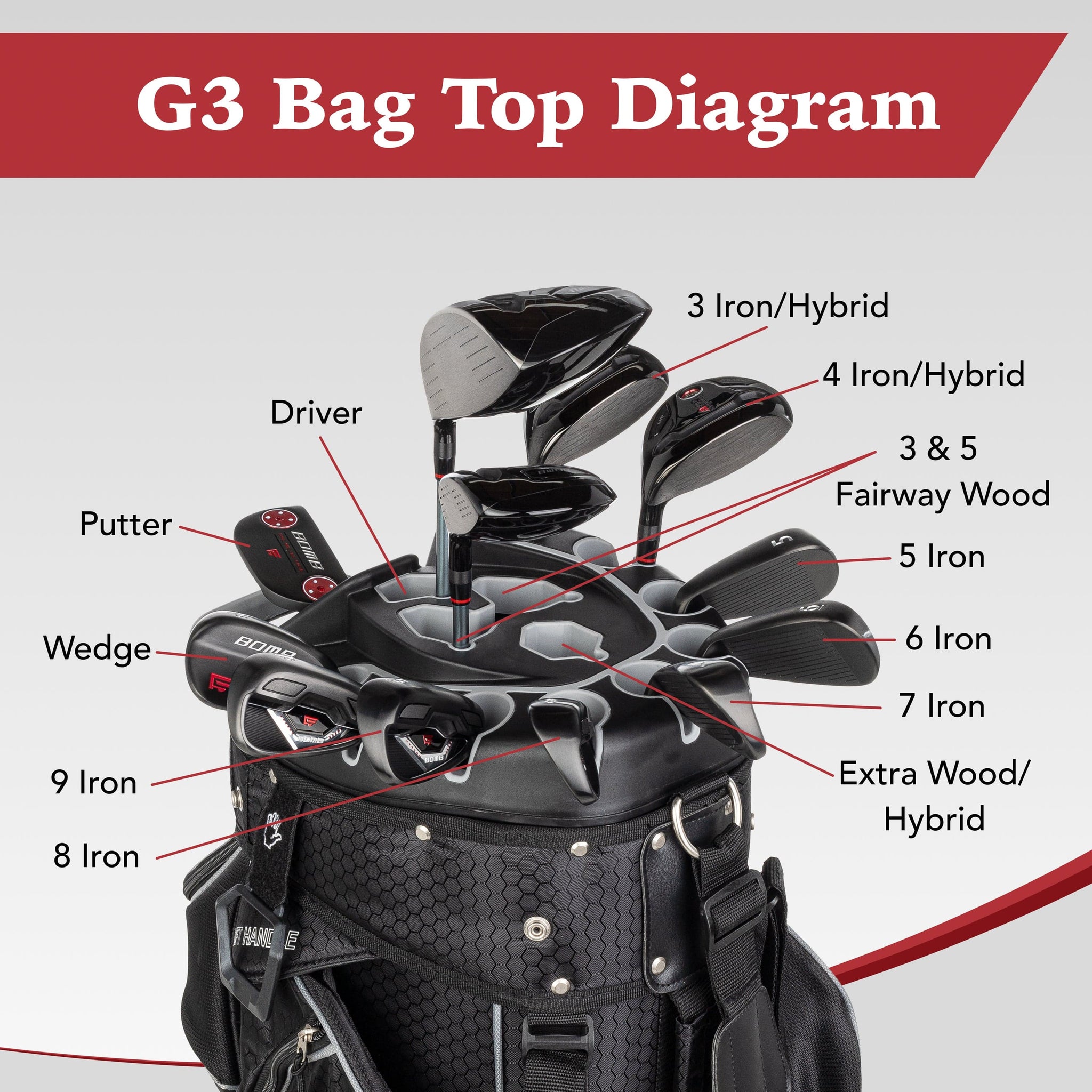
Credit: foundersclub.com
Starting With The Basics
Welcome to the essential guide on setting up your 14 club golf bag! Whether you’re a beginner aiming to refine your game or an experienced player looking to organize your gear, understanding the basics of arranging your golf bag is crucial. This walkthrough will equip you with the knowledge needed to efficiently manage your equipment, potentially enhancing your game.
Golf Bag Sections And Their Purpose
Maximize functionality and efficiency on the course by familiarizing yourself with the different sections of your golf bag. Each compartment is designed to serve a unique purpose:
- The large back section typically hosts your woods, including your driver and fairway woods, due to their longer shafts.
- Graduating to the middle sections, you’ll find the perfect spots for your irons. This keeps them accessible and organized by number.
- The front pockets are ideal for shorter clubs, like wedges and specialty clubs, ensuring quick retrieval.
To optimize space, consider additional pockets dedicated for balls, tees, and personal items.
Recognizing The Role Of Each Golf Club
Success on the greens stems from a clear understanding of what each golf club brings to your game. From powerful drives to precision putting, each club has a specific role:
| Club Type | Primary Use |
|---|---|
| Woods | Long-distance shots from the tee or fairway |
| Irons | Versatile clubs for a range of distances and shots |
| Wedges | Short-distance, high-accuracy shots and escaping hazards |
| Putters | Rolled balls on the green aiming for the hole |
The Standard 14 Club Composition
Compliance with golf’s regulations starts with the standard 14 club limit. A typical golf bag includes:
- 1 Driver
- 2 Fairway Woods (commonly a 3-wood and 5-wood)
- 1 Hybrid (can vary depending on player preference)
- Irons ranging from 4 to 9
- 3 Wedges (pitching wedge, sand wedge, and either a gap wedge or lob wedge)
- 1 Putter
Balance between club types ensures coverage for various distances and shot scenarios. Customization to complement your playing style is key, considering the selection of your irons, wedges, and specialty clubs.
Customizing Your Club Layout
Assembling the perfect golf bag takes more than just tossing in 14 clubs and hitting the green. A strategically organized bag can shave strokes off your game by ensuring you have the right tool at hand at all moments. In this guide, we’re diving into the art of customizing your club layout, tailored to harmonize with your game strategy and adapt to various course challenges.
Balancing between Woods, Irons, and Hybrids
Balancing Between Woods, Irons, And Hybrids
Your golf bag should tell a story of balance, where every character—wood, iron, and hybrid—plays its role with purpose. Start by evaluating your playing style: Do you rely on the precision of irons, or do you favor the distance woods provide? Maybe hybrid clubs are your equilibrium. To reflect this in your bag setup:
- Allocate upper slots for your woods, including your driver and fairway woods, for easy access.
- Central slots are ideal for your irons—group them from low to high, as you’ll usually select these based on shot distance.
- Hybrids, the versatile heroes, should sit between woods and irons or replace the long irons you’re less comfortable with.
Positioning For Quick Access
The heat of the game requires swift club selection. No player wants to rummage through a maze of grips and shafts to find their pitching wedge. Properly position your clubs to ensure the flow of the game remains uninterrupted. Use the following tips:
- Set wedges and putter: These are often used clubs, so place them in the lower/rear slots for quick draw and return.
- Group similar clubs: Keep clubs similar in length together to prevent tangling and improve visual identification.
- Consider bag layout: Some bags have individual slots or a preferred arrangement—use these to your advantage.
Weather And Course Condition Considerations
Weather and course conditions can be relentless variables. Equip your bag for the elements and terrain. Consider:
| Condition | Adjustment |
|---|---|
| Wet Course | Increase the number of wedges to navigate mud and soggy greens. Store rain gloves and waterproof gear in accessible pockets. |
| Windy Conditions | Consider more weight to your clubs for stability, and add low-lofted irons that can cut through gusts. |
| Sand Traps | Ensure your sand wedge is within easy reach for those pesky bunker shots. |
| Hard Ground | Stow fewer woods and stock extra irons, which can better manage tight lies. |
Practical Guide To Golf Bag Setup
Welcome to your practical guide to golf bag setup. Positioning your clubs for quick access and weight distribution is essential for a smooth golfing experience. This guide provides a step-by-step walkthrough on club placement and tips for efficient organization. Whether you’re a beginner or an experienced golfer, optimizing your bag setup can enhance performance and improve your game.
Step-by-step Walkthrough On Club Placement
Setting up your 14-club golf bag strategically is crucial for both ease of use and to prevent damage to your clubs. Follow these simple steps to ensure your clubs are placed correctly:
- Start with the driver – Place your driver and other woods at the top of your bag. These are typically the longest clubs and should be easily accessible.
- Organize irons – Position your irons (from the longest to the shortest) in the middle compartments. Some bags feature dedicated slots for each iron for added protection and organization.
- Wedges at the ready – Your sand, pitching, and lob wedges should follow the irons, usually stored towards the bottom of the bag.
- Putter’s place – Many golf bags come with a protective putter well. Use this to protect your putter’s shaft and head.
- Remember the extras – Don’t forget to include your hybrid or utility clubs if they’re part of your setup. Ideally, place them between your woods and irons.
Tips For Efficient Organization
Organizing your golf bag goes beyond just club placement. Consider these additional tips to keep your bag efficient and gameplay-ready:
- Utilize pockets strategically, storing frequently used items like golf balls, tees, and a golf glove in the most accessible locations.
- Employ a bag with full-length dividers to protect your club grips and make it easier to pull out the right club.
- Maintain a clean and dry towel attached to your bag for easy cleaning of club faces and golf balls.
- Keep valuables secure in a dedicated pocket, ideally waterproof, to protect against any weather conditions.
- Weigh your bag periodically – Proper weight distribution can save you energy during your round, ensuring that the weight does not lean too heavily on one side.
Remember, the key to an efficient golf bag setup is to establish a system that suits your style of play and makes accessing your clubs and accessories as streamlined as possible.
Maintaining Your Golf Bag Arrangement
Properly maintaining your golf bag arrangement is essential to ensure both the longevity of your golf equipment and your efficiency on the course. A well-organized golf bag helps you find the right club when it matters, reduces unnecessary wear and tear, and keeps your focus solely on your game. Let’s dive into the best practices for keeping your 14-club golf bag in top-notch condition.
Routine Checks And Adjustments
To preserve the order inside your golf bag, routine checks are crucial. Implementing a consistent process for reviewing your bag’s contents can prevent clutter and disarray. After each round, take a moment to:
- Ensure each club is returned to its designated spot.
- Check for excess dirt or grass and clean accordingly.
- Review all pockets for used tees, balls, and other accessories that can be discarded or replaced.
- Reordering your clubs based on usage or comfort.
- Inspecting club grips and shafts for signs of wear.
Organizational Accessories And Tools
Investing in organizational accessories can greatly enhance the functionality of your golf bag. Consider these tools to keep your bag tidy:
- Club headcovers to protect your clubs and reduce noise.
- Divider systems for separating clubs within the bag.
- A multi-pocket layout where each item has a place, including markers, gloves, and scorecards.
Attachment points for brushes and club-cleaning tools keep maintenance tools within easy reach. This systematic approach to organizing can save time during play and extend the life of your equipment.
Dealing With Wear And Tear
Regular use of a golf bag naturally leads to wear and tear. To manage this inevitable aspect, take steps to:
- Inspect your bag for any rips, broken zippers, or loose stitching.
- Address minor damage immediately to prevent further deterioration.
- Use waterproof sprays for fabric bags to maintain water resistance.
Should significant wear be detected, don’t hesitate to consider a replacement. A new bag can offer improved features and better protection for your clubs.
Frequently Asked Questions Of How To Set Up 14 Club Golf Bag
What Is The Proper Way To Organize A Golf Bag?
A well-organized golf bag aligns clubs by type and frequency of use. Starting at the back, place longer clubs like woods and drivers. In front, arrange irons by ascending number, with wedges and putter accessible at the front for easy reach.
How Do You Balance A 14 Club Golf Bag?
Balance your golf bag by evenly distributing clubs and gear weight. Woods and driver at the back, mid-irons in the middle, and shorts irons, wedges, and putter at the front. Keep balls, tees, and accessories in side pockets to maintain stability.
Can You Carry More Than 14 Clubs In A Golf Bag?
According to USGA rules, golfers are limited to a maximum of 14 clubs in a bag during a round. Exceeding this count can result in penalties in official play. It’s crucial to select and organize clubs strategically for different courses and shots.
What’s The Best Way To Select Golf Clubs For My Bag?
Select clubs based on your playing style, skill level, and the courses you frequent. Include a mix of drivers, irons, wedges, and a putter to cover various distances and situations. Professional fittings can be invaluable in choosing the right clubs for your swing.
Conclusion
Organizing your 14-club golf bag effectively can transform your game. By following the steps outlined in this blog, your clubs will be arranged for quick selection and optimal balance. Remember, a well-prepared bag leads to a smoother game. Embrace the strategy; let the fairways be your canvas.
Happy golfing!

Hi I am Fahad, the mastermind behind the bag revolution. Join me on a journey where style meets sustainability and discover a world of extraordinary bags.

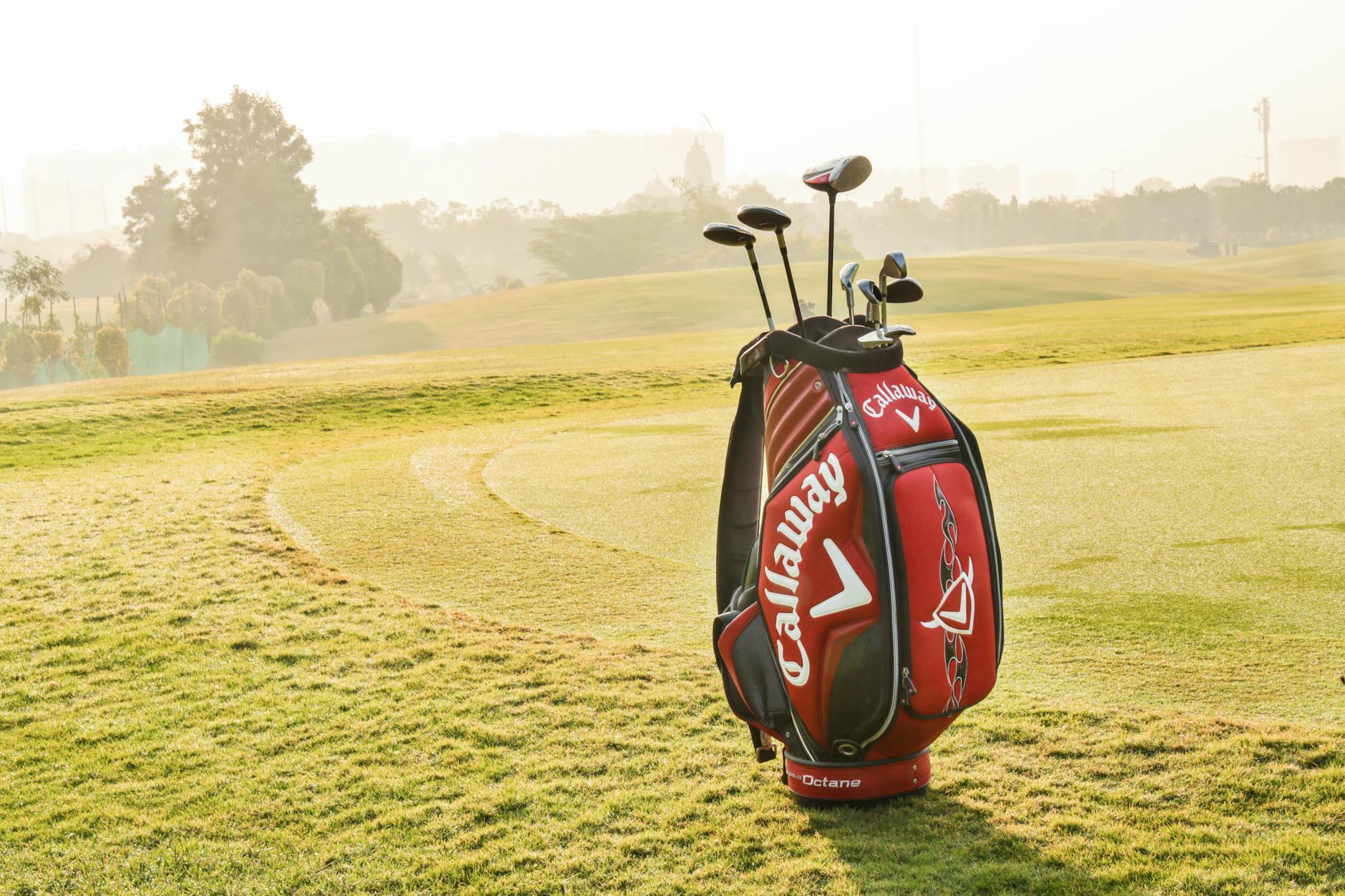


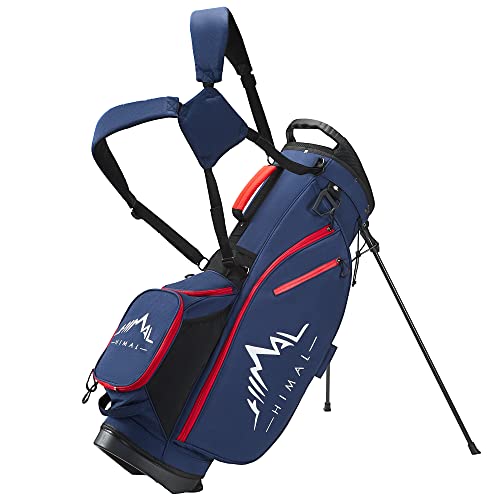
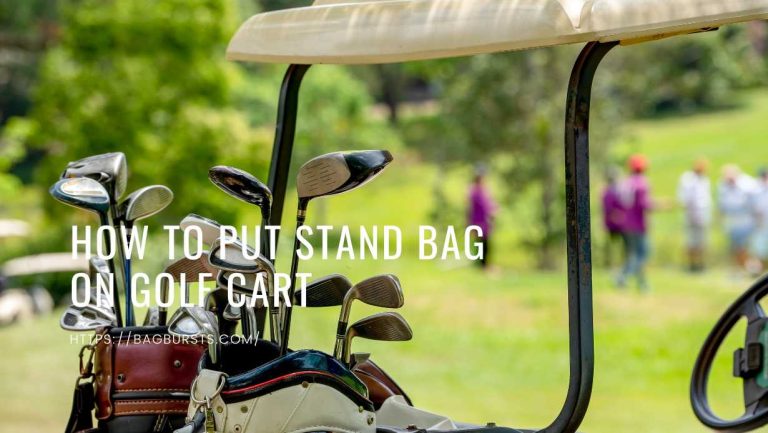

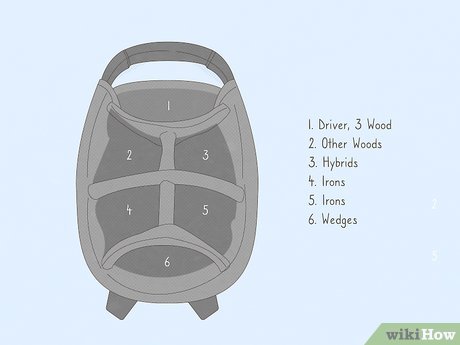


6 Comments